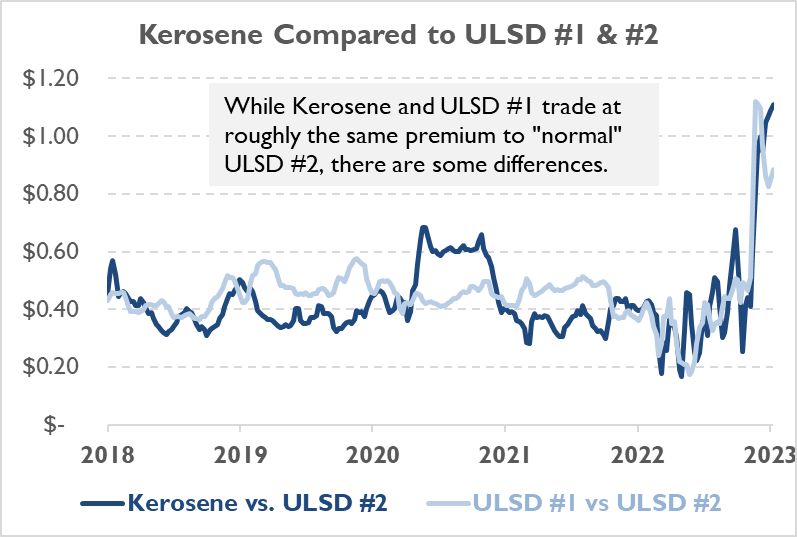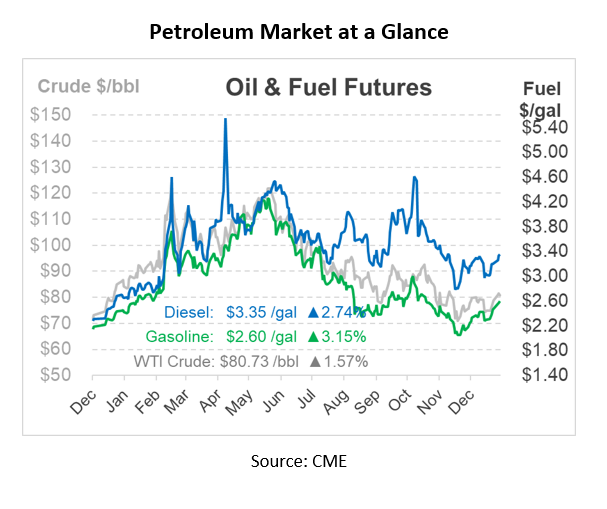
What Is It – Kerosene
Analysis by Sydney Casey
Kerosene, also known as paraffin or lamp oil, is a clear, colorless liquid that is derived from petroleum. It is commonly used as a fuel for lamps and small engines, as well as for heating and cooking in some parts of the world. Kerosene has a high flash point, which means it is less likely to ignite spontaneously than other fuels, and it is also relatively stable and easy to store. It has a distinctive, slightly pungent smell and is usually sold in containers specifically designed for use with the substance.
Kerosene is a type of fuel that is commonly used in aviation, as well as in some types of diesel engines. In some parts of the world, particularly in areas where the temperatures fall below freezing, kerosene is used as a diesel fuel. It is less commonly used as fuel for ground transportation, although it has been used in the past for this purpose. Kerosene must meet the requirements set in ASTM D3699.
What is the Difference between Kerosene and Diesel?
Kerosene and diesel fuel are similar products, but they are not exactly the same. First, it’s important to remember that “diesel” can describe many different products, but here we’ll use it to describe Ultra-Low Sulfur Diesel #2, the most common form used by trucks, generators, off-road equipment, etc. Kerosene is a more refined fuel, with fewer impurities than diesel fuel. This is why kerosene used to be burned indoors, as diesel left a strong odor when burned inside.
You may have heard kerosene and “Diesel #1” used interchangeably. While they’re not exactly the same thing, they are similar enough that the terms often overlap. Diesel #1 is a product with a lower density and flash point than #2, among other differences. Technically, kerosene is governed by ASTM D3699, while diesel #1 is governed by the same spec (ASTM D975) that regulates “normal” diesel. A gallon of fuel could meet both kerosene and diesel #1 requirements, but the standards for #1 diesel are a bit less stringent than those for kerosene. Either way, you’re likely to hear about “kero blends” during the winter; even though it’s more likely you’re receiving diesel #1, either will work.
What is the Difference Between Kerosene and Gasoline?
Kerosene and gasoline are both types of fuels derived from petroleum, but they have very different chemical makeups and uses. One key difference between the two fuels is their volatility, or how easily they vaporize and catch fire. Gasoline has a much lower flash point than kerosene, which means it is more prone to ignite and is more dangerous to handle. This is why gasoline is typically used as a fuel for spark-ignition engines, such as those found in most cars. On the other hand, Kerosene is used in compression-ignition engines, such as those found in diesel engines.
Another difference between the two fuels is their chemical makeup. Kerosene has a higher molecular weight and a lower octane rating than gasoline. This means it has a lower energy density and is less efficient than fuel. It is also less refined than gasoline, which means it contains impurities and contaminants that can affect its performance and stability.
Where Can I Purchase Kerosene?
Kerosene is available for purchase at a wide variety of retail outlets. Many gas stations sell the substance at the pump or in containers that you can take with you. It is important to note that kerosene is a flammable substance that should be handled and stored carefully to prevent accidents. Always follow the instructions on the label when using kerosene.
How Much Does Kerosene Cost?
The cost of kerosene can vary depending on a number of factors, including geographical location, demand, and the type of kerosene being purchased. In general, kerosene tends to be more expensive than gasoline or diesel, especially during the winter. Typically, kerosene is roughly 40 cents more than diesel fuel, though in recent years the premium has fallen as low as 20 cents and as high as $1.00. That means that an 80/20 kero blend in the winter (80% diesel, 20% diesel #1 or kerosene) is roughly 8-10 cents more than regular diesel.
Source: OPIS
This article is part of Daily Market News & Insights
Tagged: Daily Market News & Insights, diesel, fuel prices, gas prices, gasoline, production, Supply
MARKET CONDITION REPORT - DISCLAIMER
The information contained herein is derived from sources believed to be reliable; however, this information is not guaranteed as to its accuracy or completeness. Furthermore, no responsibility is assumed for use of this material and no express or implied warranties or guarantees are made. This material and any view or comment expressed herein are provided for informational purposes only and should not be construed in any way as an inducement or recommendation to buy or sell products, commodity futures or options contracts.







